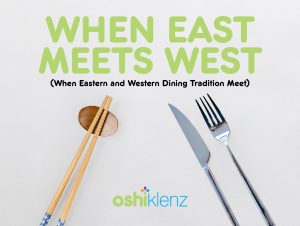
When East Meets West, In almost any part of the world, especially the West, there are restaurants that serve Eastern or Asian cuisine. And along with the dishes they serve. These restaurants also follow long-held traditions and etiquette that give a unique dining experience to their customers.
What happens when these Eastern traditions meet Western culture? This article will discuss some notable dining etiquette of both the East and West. How they differ and if there are some similarities between the 2.
Utensils usage. Western culture primarily uses a fork and knife when eating while many Asian countries use chopsticks as the main eating utensil.
In Japan, for example, polite eating has much to do with your ability to handle chopsticks. Your access to eating utensils will be pretty limited.
Table and seating configuration. It’s safe to say that anywhere in Western countries, customers dine while sitting at conventional tables and chairs. In Japan, however, you may sit on a tatami, a traditional Japanese mat, at a low set table. The proper way to sit is with your heels tucked beneath you.
Additionally, dining at round tables is common in Asian cultures since it encourages inclusivity no matter where one sits. When dining at a round table, everyone can chat and connect with each other while eating.
Also, the eldest or most senior person usually takes the seat facing the entrance, symbolic of respect.
On the other hand, eating at rectangular tables is more common in Western cultures. One might not get the chance to chat with every single person when seated at this kind of table but it highly encourages small chat between people seated beside each other.
Dish serving sizes. One of the main differences between Western and Eastern eating habits is how the food is portioned and served on the table.
In many Eastern cultures, main dishes are designed to be shared with other people as a symbol of unity. Communal eating is a respectful experience of collectivism. A multitude of dishes is put into the middle of the table for each member of the meal to share with their dining companions.
In Western culture, individual dishes are the norm. The food is placed in front of an individual’s table setting to directly consume for themselves. Bigger meals are served during holiday affairs but individual portions of a dish are the standard of circadian dining.
Other notable dining etiquettes:
In Japan, if you’re after a refill it’s a game of giving and take. You can subtly hint that you’ve run dry by topping up the glass of another diner, and wait for them to return the favour.
Once seated in a Japanese restaurant, you will be provided with a hand towel called the “Oshibori”. It’s used to wipe your hands before and after a meal and is expected to be folded neatly after you’re finished using them.
Of all the different traditions, this one has gained popularity not only in Eastern cultures but in the West as well. Nowadays, oshibori or hot towels are being used not only in restaurants but also in other establishments like clinics and spas because it provides a good feeling to customers.
If you own a restaurant or wellness clinic, your business will benefit from providing hot towels to customers. Here at Oshiklenz, we provide a vast variety of hot towels and towel warmers.
We also have special packages that can be customized depending on your specific needs. Call us now and our customer representative will be glad to assist you.
